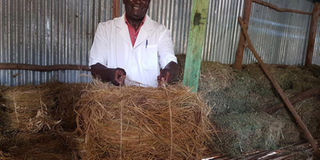Breaking News: KDF chopper crash kills five
Farm grass, it’s my fodder for creating wealth

Hezron Anyona displays a bale of Mulato grass. Mulato is drought-tolerant, recovers fast after grazing, offers good quality forage and is tasty to livestock. PHOTO | RACHEL KIIBUI | NATION MEDIA GROUP
What you need to know:
- Mulato is a variety of brachiaria grass, a cross of ruzigrass (Brachiaria ruziziensis) and palisadegrass (Brachiaria brizantha).
- On average, he gets about 200 bales of mulato and Boma Rhodes from an acre and sells each at Sh250. Desmodium, on other hand, goes at Sh300 per bale.
- The dairy sector is currently grappling with acute shortage of fodder following the dry season and farmers like Anyona are reaping big.
- By drying and preserving fodder well, nutrients such as proteins and carbohydrates, which supply energy and stimulate milk production are conserved.
A drive along the mighty Lake Victoria in Homa Bay County is breath-taking as one watches waves rise up and down in a beautiful pattern.
Along the way, we meet herds of indigenous cattle heading or coming from the lake, where they go to drink water.
Not far from the lake in Sikri village is Hezron Anyona’s farm, where he grows various kinds of fodder for sale.
Anyona farms mainly mulato grass on five acres that he harvests and turns into hay for sale.
Mulato is a variety of brachiaria grass, a cross of ruzigrass (Brachiaria ruziziensis) and palisadegrass (Brachiaria brizantha).
“I also grow Boma Rhodes and desmodium but mulato is the main fodder. I recently uprooted the first two after five years of harvesting and I am looking forward to planting anew,” says Anyona, who does not keep any dairy cattle.
Mulato is drought-tolerant, recovers fast after grazing, offers good quality forage and is tasty to livestock. “I normally water the grass twice every week, on Tuesdays and Fridays,” he says.
Anyona, an independent construction engineer, started farming in 1989, but he did not begin with the fodder.
“I used to plant horticultural crops like melons, tomatoes and vegetables. However, monkeys would not give me peace. They would wait until the crops are ready for harvest and destroy them,” says Anyona, whose farm is in the middle of Gembe and Sikri hills, hideouts for monkeys.
To try and protect the crops, the farmer would hire people to chase away the monkeys.
However, 2006 was his turning point as the monkeys feasted on his two acres of melons, which were ready for the market.
“It still pains me to date as I remember I incurred losses of about Sh200,000,” said the farmer, 62, who later decided to switch to dairy farming, starting by planting fodder as he prepared to purchase cows.
CUT EXPENSES
However, by the time his first one-and-a-half-acre of desmodium, mulato and Boma Rhodes (half-acre each) was ready, he had not yet bought his first cow and he is yet to purchase 10 years later.
“As soon as the fodder matured, dairy farmers started approaching me asking to buy it. Since I was not ready with my cows, I realised it was not a bad idea to sell,” says Anyona, who invested over Sh200,000 when starting farming.
By December last year, he had a total of 12 acres of fodder. Mulato sits on five, Boma Rhodes four and desmodium three.
“Right now I only have mulato on two acres after I cleared 10 acers to replant. My target this year is to grow the fodder on 15 acres and double in two years because demand is too high that I cannot meet,” says Anyona, who sells the fodder to farmers in Rongo, Kisumu and Sotik.
On average, he gets about 200 bales of mulato and Boma Rhodes from an acre and sells each at Sh250. Desmodium, on other hand, goes at Sh300 per bale. He harvests all the fodder thrice a year.
“I normally cut the fodder at three months and leave it on the ground for two – three days to dry. Thereafter, I use a manual baler to compress it and I tie the bales with a sisal thread,” says Anyona, noting he buys fodder seeds from Kenya Seed Company at Sh1,000 per kilo.
He used to employ at least 15 people when he was farming melons and tomatoes, and if he would have kept cows, the number would have remained higher and so are his expenses.
GO FOR FODDER AGRIBUSINESS
But with fodder, he now has only two permanent workers, and occasionally hires four casuals.
“I have attended several trainings by the Kenya Agricultural Value Chain Enterprises offered at Egerton University, among other agricultural institutions on fodder production.”
The dairy sector is currently grappling with acute shortage of fodder following the dry season and farmers like Anyona are reaping big.
Beverly Shitadi, a Senior Dairy Specialist at USAID, says fodder farming is a lucrative business as many people concentrate on keeping dairy cows.
“People with huge parcels of land should go for fodder agribusiness and supply to small-scale dairy farmers who own even less than an acre. If fodder is made available throughout the year, then low milk production would be a thing of the past,” says Shitadi, adding fodder production should not only focus on Boma Rhodes grass as is the case, but also lucern and desmodium which are high in protein.
Shitadi notes by drying and preserving fodder well, nutrients such as proteins and carbohydrates, which supply energy and stimulate milk production are conserved.
Kenyan grass
- Brachiaria was initially taken from the country during the colonial era to as far as Montpelier in France for research purposes.
- The grass has been embraced by dairy and beef farmers in Brazil, Colombia and Australia, and is now back into the country.





